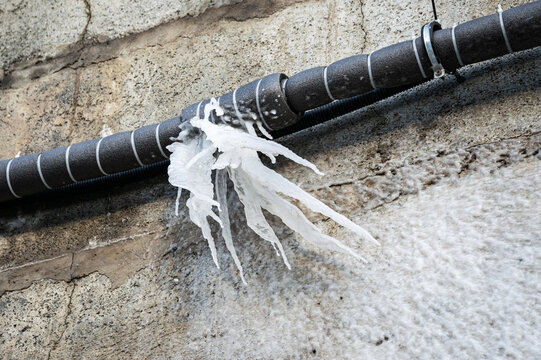The writer is making a number of great annotation about Preventing and dealing with frozen pipes in general in this great article down the page.
:strip_icc()/snow-outdoor-faucet-pipes-4af65d1e5e904fb1aa7bf74071fe5d89.jpg)
Winter can ruin your pipes, particularly by freezing pipes. Here's how to stop it from taking place and what to do if it does.
Introduction
As temperatures decrease, the risk of icy pipes rises, potentially leading to expensive fixings and water damages. Understanding just how to stop frozen pipes is vital for home owners in chilly climates.
Comprehending Frozen Pipes
What triggers pipelines to ice up?
Pipelines freeze when subjected to temperatures below 32 ° F (0 ° C) for prolonged periods. As water inside the pipelines freezes, it broadens, putting pressure on the pipeline wall surfaces and possibly triggering them to rupture.
Threats and problems
Frozen pipes can bring about water interruptions, residential property damages, and costly repair work. Ruptured pipelines can flood homes and cause comprehensive structural damage.
Indications of Frozen Water Lines
Determining icy pipelines early can stop them from bursting.
Just how to identify frozen pipelines
Search for reduced water circulation from faucets, uncommon odors or sounds from pipes, and visible frost on subjected pipes.
Prevention Tips
Insulating at risk pipes
Wrap pipes in insulation sleeves or use warmth tape to shield them from freezing temperature levels. Concentrate on pipelines in unheated or outside areas of the home.
Home heating strategies
Keep interior areas properly heated up, specifically locations with pipes. Open up cupboard doors to allow cozy air to distribute around pipelines under sinks.
Shielding Outside Pipes
Yard hose pipes and outside taps
Detach and drain garden hoses prior to wintertime. Set up frost-proof spigots or cover outdoor taps with shielded caps.
What to Do If Your Pipelines Freeze
Immediate activities to take
If you presume frozen pipelines, maintain faucets open to alleviate pressure as the ice melts. Utilize a hairdryer or towels soaked in hot water to thaw pipelines gradually.
Long-Term Solutions
Structural adjustments
Consider rerouting pipes far from outside wall surfaces or unheated areas. Add added insulation to attics, cellars, and crawl spaces.
Updating insulation
Invest in top quality insulation for pipelines, attic rooms, and wall surfaces. Proper insulation helps keep consistent temperature levels and decreases the threat of icy pipes.
Verdict
Stopping frozen pipes needs positive actions and fast responses. By recognizing the causes, indicators, and safety nets, home owners can shield their plumbing during cold weather.
5 Ways to Prevent Frozen Pipes
Drain Outdoor Faucets and Disconnect Hoses
First, close the shut-off valve that controls the flow of water in the pipe to your outdoor faucet. Then, head outside to disconnect and drain your hose and open the outdoor faucet to allow the water to completely drain out of the line. Turn off the faucet when done. Finally, head back to the shut-off valve and drain the remaining water inside the pipe into a bucket or container. Additionally, if you have a home irrigation system, you should consider hiring an expert to clear the system of water each year.
Insulate Pipes
One of the best and most cost-effective methods for preventing frozen water pipes is to wrap your pipes with insulation. This is especially important for areas in your home that aren’t exposed to heat, such as an attic. We suggest using foam sleeves, which can typically be found at your local hardware store.
Keep Heat Running at 65
Your pipes are located inside your walls, and the temperature there is much colder than the rest of the house. To prevent your pipes from freezing, The Insurance Information Institute suggests that you keep your home heated to at least 65 degrees, even when traveling. You may want to invest in smart devices that can keep an eye on the temperature in your home while you’re away.
Leave Water Dripping
Moving water — even a small trickle — can prevent ice from forming inside your pipes. When freezing temps are imminent, start a drip of water from all faucets that serve exposed pipes. Leaving a few faucets running will also help relieve pressure inside the pipes and help prevent a rupture if the water inside freezes.
Open Cupboard Doors
Warm your kitchen and bathroom pipes by opening cupboards and vanities. You should also leave your interior doors ajar to help warm air circulate evenly throughout your home.

As an enthusiastic person who reads about How to prepare your home plumbing for winter weather, I thought sharing that piece of content was important. Sharing is good. Helping people is fun. I praise you for your time. Please come visit our blog back soon.
Call Today
Comments on “Important Advice to Prevent Frozen Plumbing in Cold Weather: Professional Insights”